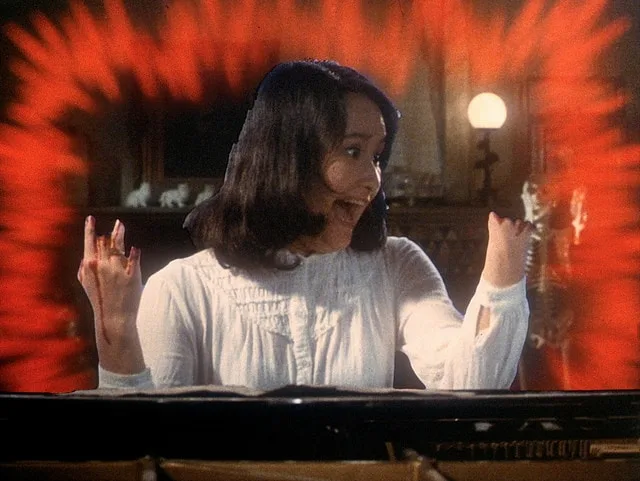
A film like House is a joy to watch. Over 40 years since it was made, Obayashi’s feature debut is a true phantasmagoria of a film: inventive, exciting and downright weird. A haunted house tale with a pop-feminine sensibility, the teen girls who populate the house might be named for their stock personality traits, yet for this suggestion of superficiality they are entirely believable and likeable characters. Performed with verve by the inexperienced actresses who portray them, this is an entirely charming cast of characters at the mercy of a vengeful haunted house.
The film is visually arresting before the girls even reach the house, with colourful, overly-saturated skies and landscapes providing the backdrop for seemingly idyllic school days for these girls. When Angel, the most popular girl, arrives home to her father who has returned from a trip a day early, that idyll is destroyed – he intends to remarry and introduces Angel to her ‘new mother’. Unhappy, and recalling her mother, Angel decides to spend the summer at her aunt’s house and invites her dear friends to join her. Their journey to the house is a delightfully girlish affair, all giggles and joy, and that is, perhaps strangely, sustained throughout the rest of the film, even as things turn grisly.
House seems to have more in common with earlier Japanese horror films than the grittier, urban violence that seems to have dominated 1970s Japanese genre cinema with the likes of the Stray Cat Rock series. House seems to feature delirious meld of the ghostly goings on of the likes of Kwaidan and Kurneko with the fun and mischief of Yokai Monsters. For all its recall of older films, though, House is decidedly modern, featuring an abundance of knowingly obvious special effects and a killer soundtrack by psych-rock band Godiego. Curious to think, then, that House would lead into the decade that Japanese horror turned extra nasty, with the likes of the Guinea Pig series emerging in abundance.

Something that struck me most of all while watching House was the parallels one could draw with Suspiria, made in the same year on the other side of the world. While on the surface quite different films, both are female-led fairy tales, with imposing buildings housing inexplicable goings on. Particular sequences even stood out – the futon-attack in House, for example, seeming like the fluffy flip-side to Sara’s fall in razor-wire in Suspiria. What a double-bill that would make for.
House is the sort of film that doesn’t appear often: firmly grounded in traditions of cinema and storytelling while offering something totally original in its execution. The absurdity and surrealism is a delight, and its blend of horror, fantasy and melodrama is delicious. There is no doubt that any number of these elements might be off-putting to viewers – a film at once able to be not enough horror and too much, for example – but for me, it’s a singular work of cinematic brilliance.
House is available now on Blu-Ray from Eureka Entertainment, as part of their Masters of Cinema range.
